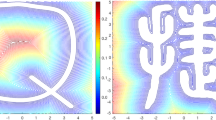Abstract
A multi-robot system that consists of N nano-robots is studied. It is assumed that the robots correspond to diffusing particles, and interact to each other as the theory of Brownian motion predicts. Brownian motion is the analogous of the quantum harmonic oscillator (Q.H.O.), i.e., of Schrödinger’s equation under harmonic (parabolic) potential. It is shown that the motion of the robots can be described by Langevin’s equation which is a stochastic linear differential equation. It is proved that Langevin’s equation is a generalization of conventional gradient algorithms. Therefore the kinematic models of mobile robots which follow conventional gradient algorithms can be considered as a subcase of the kinematic models which are derived from the diffusion analogous of the Q.H.O model.
Similar content being viewed by others
References
Hog, T.: Coordinating microscopic robots in viscous fluids. Auton. Agents Multi-agent Syst. 14, 271–305 (2007)
Louste, C., Liegeois, A.: Near optimal robust path planning for mobile robots: the viscous fluid method with friction. J. Intell. Robot. Syst. 27, 99–112 (2000)
Adamatzsky, A., de Lacy Costello, B., Melhuish, C., Ratcliffe, N.: Experimental reaction-diffusion chemical processors for robot path planning. J. Intell. Robot. Syst. 37, 233–249 (2003)
Tan, X.: Self-organization of autonomous systems via Langevin equation. In: 46th IEEE Intl. Conference on Decision and Control, pp. 1435–1440, New Orleans, 12–14 December 2007
Adamatzsky, A., Arena, P., Basile, A., Carmona-Galaán, R., de Lacy Costello, B., Fortuna, L., Frasca, M., Rodriígez-Vázquez, A.: Reaction–Diffusion navigation robot control: from chemical to VLSI analogic processors. IEEE Trans. Circuits Syst.-I: Regular Papers 51(5), 926–938 (2004)
Schmidt, G., Neubauer, W.: High speed robot path planning in time-varying environment employing a diffusion equation strategy. In: Tzafestas, S.G. (ed.) Robotic Systems, pp. 207–215. Kluwer, Dordrecht (1992)
Faris, W.G.: Diffusion, Quantum Theory, and Radically Elementary Mathematics. Princeton University Press, Princeton (2006)
Ozhigov, Y.: Amplitude quanta in multi particle system simulation. Russ. Microelectron. 35(1), 53–65 (2006)
Ozhigov, Y.: Simulation of quantum dynamics via classical collective behavior. Russ. Microelectron. 36(3), 193–202 (2007)
Levine, H., Rappel, W.J.: Self-organization in systems of self-propelled particles. Phys. Rev. E 63 (2000)
Gitterman, M.: The Noisy Oscillator: The First Hundred Years, from Einstein until Now. World Scientific, Singapore (2005)
Duflo, M.: Algorithmes stochastiques. In: Mathématiques et Applications, vol. 23. Springer, New York (1996)
Benvensite, A., Metivier, P., Priouret, P.: Adaptive algorithms and stochastic approximations. In: Applications of Mathematics Series, vol. 22. Springer, New York (1990)
Gazi, V., Passino, K.: Stability analysis of social foraging swarms. IEEE Trans. Syst. Man Cybern. Part B 34, 539–557 (2004)
Rigatos, G.G.: Coordinated motion of autonomous vehicles with the use of a distributed gradient algorithm. In: Applied Mathematics and Computation. Elsevier, Amsterdam (2008)
Rigatos, G.G.: Cooperative behavior of mobile robots as a macro-scale analogous of the quantum harmonic oscillator. In: IEEE SMC 2008 Intl. Conference, Singapore, September 2008
Rigatos, G.G.: Distributed gradient and particle swarm optimization for multi-robot motion planning. In: Robotica. Cambridge University Press, Cambridge (2008)
Klebaner, F.C.: Introduction to Stochastic Calculus with Applications. Imperial College Press, London (2005)
Comet, F., Meyre, T.: Calcul Stochastique et Modèles de Diffusion. Dunod, Paris (2006)
Rigatos, G.G., Tzafestas, S.G.: Quantum learning for neural associative memories. Fuzzy Sets Syst. 13(157), 1797–1813 (2006)
Basseville, M., Nikiforov, I.: Detection of Abrupt Changes: Theory and Applications. Prentice-Hall, Englewood Cliffs (1993)
Cohen-Tannoudji, C., Diu, B., Laloë, F.: Mécanique Quantique I. Hermann, Paris (1998)
Müller, G.: Quantum Mechanics: Symmetries, 2nd edn. Springer, New York (1998)
Rigatos, G.G., Tzafestas, S.G.: Parallelization of a fuzzy control algorithm using quantum computation. IEEE Trans. Fuzzy Syst. 10, 451–460 (2002)
Dubois, D., Foulloy, L., Mauris, G., Prade, H.: Probability-possibility transformations, triangular fuzzy sets and probabilistic inequalities. Reliab. Comput. 10(4), 273–297 (2004)
Rigatos, G.G., Tzafestas, S.G.: Neural structures using the eigenstates of the quantum harmonic oscillator. Open Syst. Inf. Dyn. 13, 27–41 (2006)
Rigatos, G.G.: Quantum wave-packets in fuzzy automata and neural associative memories. Int. J. Mod. Phys. C 18(10), 1551–1569 (2007)
Tzafestas, S.G., Rigatos, G.G.: Stability analysis of an adaptive fuzzy control system using Petri Nets and learning automata. Math. Comput. Simul. 51(3), 315–341 (2000)
Rigatos, G.G.: Open-loop control of particle systems based on a model of coupled stochastic oscillators. In: ICQNM 2009, 3rd Intl. Conference on Quantum, Nano and Micro Technologies, Cancun, February 2009
Rouchon, P.: Flatness-based control of oscillators. Z. Angew. Math. Mech. 85(6), 411–421 (2005)
Author information
Authors and Affiliations
Corresponding author
Rights and permissions
About this article
Cite this article
Rigatos, G.G. Cooperative behavior of nano-robots as an analogous of the quantum harmonic oscillator. Ann Math Artif Intell 55, 277 (2009). https://doi.org/10.1007/s10472-009-9130-0
Received:
Accepted:
Published:
DOI: https://doi.org/10.1007/s10472-009-9130-0




